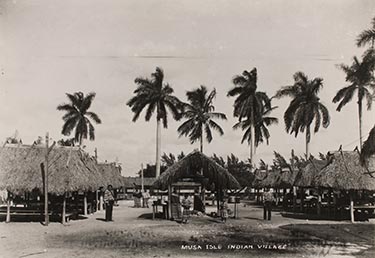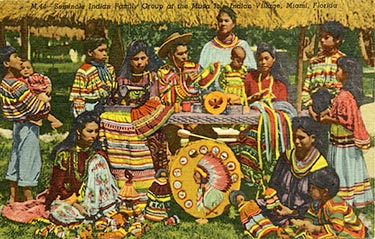Dolls and Tourism
In the early 1900s, Florida became a tourist destination, where people wanted to see the “exotic Indians” of the Everglades. The Seminole and Miccosukee realized that they could sell dolls to tourists to make money, which they needed because they were living in desperate poverty. The Seminole and Miccosukee were very poor because their environment had changed due to dwindling game and the draining of the Everglades for agriculture.
Musa Isle Indian Village

The Seminole and Miccosukee began working at tourist attractions such as Indian Villages and Alligator Farms for an income in the early 1900s. The most famous of these villages was the Musa Isle Indian Village (Figure 1), located on the Miami River. At these villages tourists could watch Seminole and Miccosukee tribal members perform daily tasks such as cooking and craft making. Seminole and Miccosukee dolls were created to sell to tourists for income. The dolls were sold for 10 cents each and became popular with tourists. More information about Musa Isle Indian Village can be found here.
Deaconess Bedell

In 1933, Harriet Bedell, a Deaconess who ran the Episcopalian Glade Cross Mission in Southwest Florida, devoted her time to help the Seminole and Miccosukee expand their craft enterprise. Bedell was in charge of craft production at the Mission and set strict guidelines that both tribes had to follow.
One of Bedell’s concerns was the quality of items being sold. She eliminated anything that was seen as unauthentic to the Seminole and Miccosukee cultures. Such items included tomahawks, peace pipes, and totem poles, which had been sold at the Indian Villages in Florida despite the fact that they came from different tribal nations from across the country. Figure 2 is a postcard that shows such items that would have been sold at the Musa Isle Indian Village where Bedell’s influence had not yet reached. Read more about Bedell and see photos of her work with the Seminole and Miccosukee.